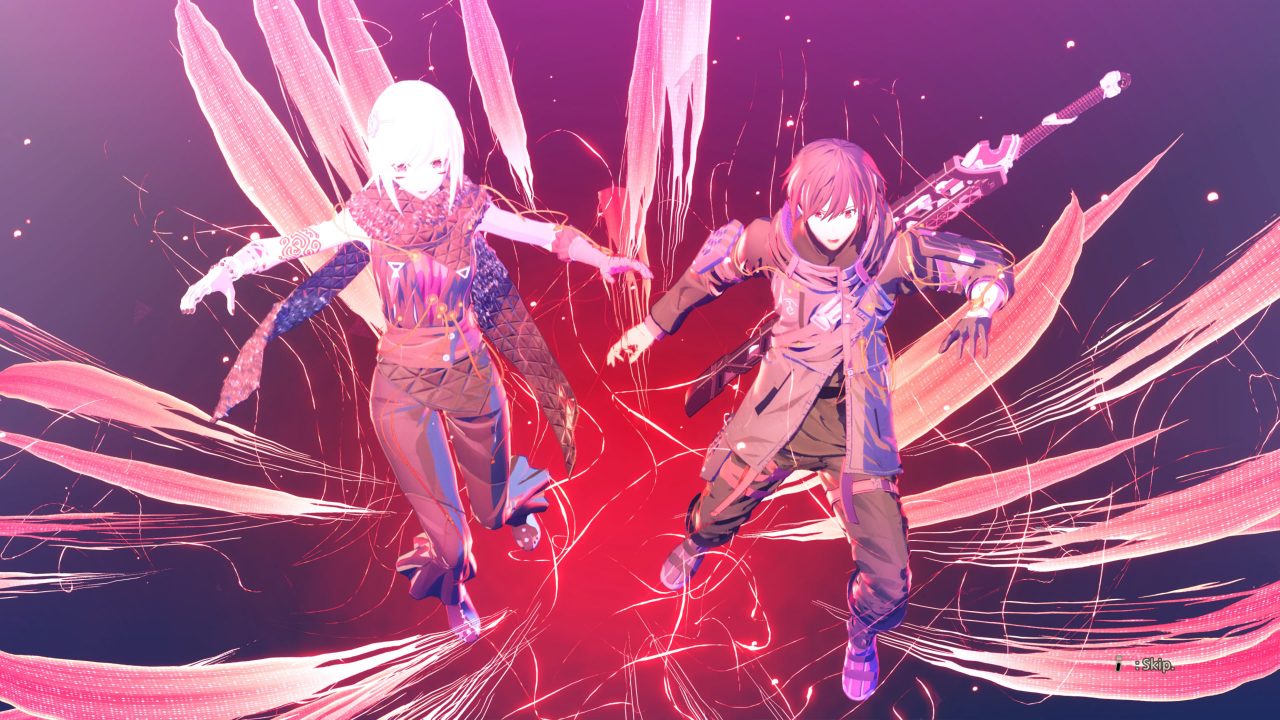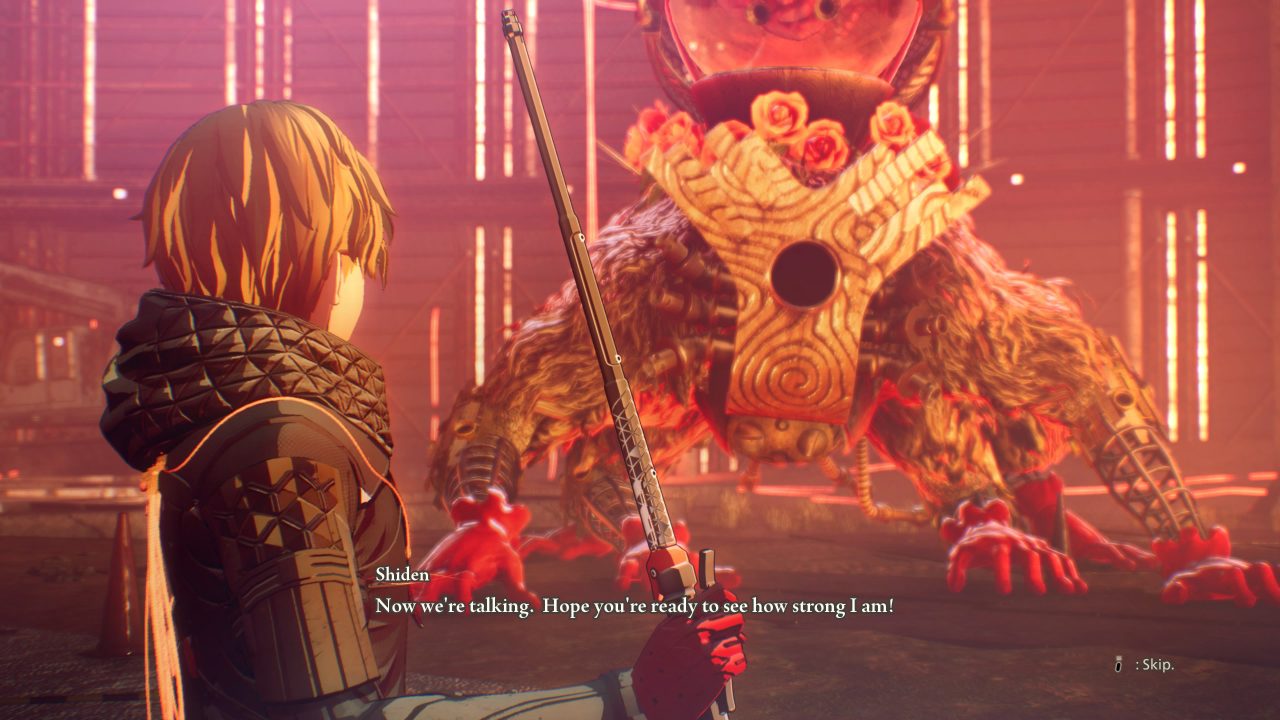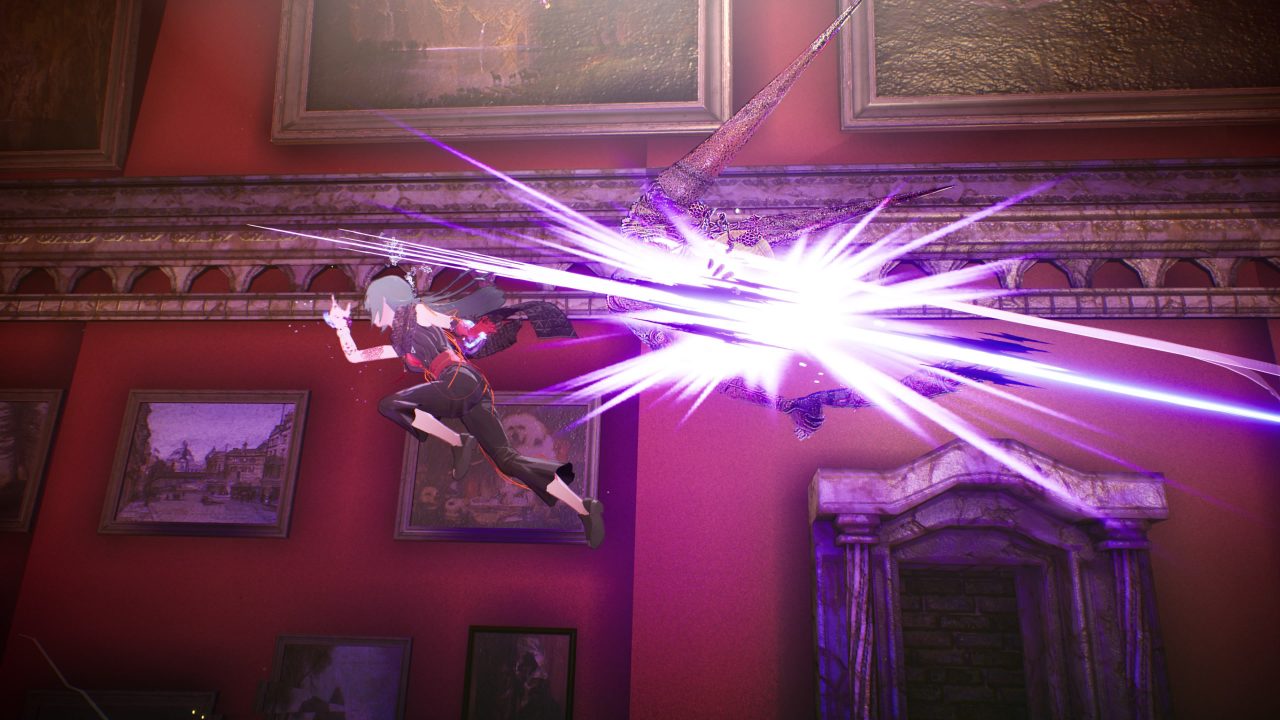When first revealed at Xbox 20/20 last year, Scarlet Nexus came as a surprise announcement during an uncertain time for video game news and consequently drew many eyes. Connections were immediately drawn to Bandai Namco’s Code Vein due to Nexus’s art style, and while some quickly wrote it off as just another anime game, a few (like myself) got very excited to see a brand new JRPG. Luckily, we didn’t have to wait too long to have Scarlet Nexus in hand, and it enters the playing field as a unique, strange, sometimes messy, but ultimately worthwhile experience.
Bandai Namco coined the term “brainpunk” to describe Scarlet Nexus, and the final product does much to live up to this new genre. It’s set on an alternate Earth where 99% of the human population has psionic powers. These powers are used in conjunction with a massive computer network to create a world of telepathic communication, instant data look-up, cyberpunk-esque neon, and jazzy electronic beats.
Early on, you see how the government uses the network to control every experience of its citizens, even censoring the corpses of soldiers killed in action to protect the mental state of your party. What are soldiers being killed by, you ask? The Others — grotesque creatures that are an amalgam of organic and inorganic matter such as human, animal and plant parts as well as mechanical and household objects. Others come from the Extinction Belt, a mysterious cloud-like substance that encircles the planet. They also eat brains. So the government formed the Other Suppression Force, a group of powerful psionics trained in combat (whether they wish it or not), to counter the Others.
Psionic abilities deteriorate with age, so promising young people are scouted into the military and fed anti-aging drugs. A lot of anime and RPGs have characters of indeterminate age, and it is something of a meme at this point, but Scarlet Nexus utilizes this as an important in-world concept. There are characters who struggle with this, such as scarred veterans who are child soldiers that were never allowed to grow up.
Scarlet Nexus allows you to choose your protagonist: Yuito, son of the New Himuka chairman and descendant of humankind’s legendary hero, or Kasane, adopted daughter of the Randall family, who run the rich and powerful Randall Industries. They share the same psionic power, psychokinesis, but otherwise have quite a few differences, including party members, skill trees, and weapons. The change in viewpoint also leads to story revelations that come sooner or later depending on which protagonist you choose, and you’ll even experience some events firsthand as one character that the other only hears about secondhand. Their stories are purposefully intertwined, which fits one of the larger narrative themes of the game: connections.

Scarlet Nexus’s development team includes many Tales series veterans, and you don’t have to look hard to notice it. For example, the standard healing item is called a jelly — a clear reference to the gels of the Tales series, which serve the same function. However, one way in which Scarlet Nexus stands out and claims its own identity is the look of the Others. They were designed by Masakazu Yamashiro, an independent Japanese artist who has never worked on a video game before and is known for his twisted creations. His designs are uniquely unsettling (NSFW warning if you plan on looking him up) and fit the alien nature of the creatures within the game, lending Scarlet Nexus a powerful visual impact.
Outside of the Others, Scarlet Nexus’s art is more classically “anime.” In my opinion, the game owns this aesthetic and is one of the best examples of the style. Characters and backgrounds fit together well, expressions are emotionally readable, and everything is silky smooth in all its neon glory. Bandai Namco has also found a good solution for the more minimalist cutscenes in Scarlet Nexus. While some cutscenes are fully animated, others are instead presented in a manga style, with each panel featuring minor animations. This not only looks appropriately stylized, but it doesn’t make the cutscenes feel low budget like other attempts in a similar vein often do.
The bulk of your time in Scarlet Nexus is spent in combat, and this is also where the game shines brightest. The basic flow involves beating up enemies to either reduce their health or crush gauge. When the crush gauge is reduced to zero, you can activate a flashy instant kill move called a Brain Crush that guarantees an item drop. You have a vast array of combat options, and Scarlet Nexus makes great use of the entire controller to grant you quick access. The d-pad allows you to scroll through and use items. The face buttons provide your basic attacks (melee sword swings for Yuito, and ranged knife throws for Kasane) and also let you dodge and jump. The right shoulder button plus a face button grants you a buff (called Combat Vision) from a party member, like hyperspeed, electric attacks or teleportation. If your bond is strong enough, the left shoulder button plus a face button results in a direct attack known as an Assault Vision from the corresponding ally.

The controller’s triggers activate your psychokinetic powers at a cost to your psychokinesis gauge: right trigger to toss various junk at your enemies, left trigger to interact with QTE-driven “gimmick” objects. These gimmick objects are often instrumental in making quick work of bosses and lead to some of the most fun gameplay moments, like running down groups of Others from atop a city bus. When playing on PS5, the haptic feedback and adaptive triggers of the DualSense are tied to your psychokinesis and feel surprisingly great.
Brain Drive is another important combat mechanic. Your drive gauge fills as you defeat enemies and take damage. When the gauge is full, you automatically enter Brain Drive, where you move faster, hit harder, and receive a variety of bonuses depending on what you have unlocked in your brain map. I do wish you could choose when to trigger this transformation, but it is a fun mechanic. Finally, after you have used Brain Drive, you can activate your Brain Field with a click of both sticks. This gives you a high only anime can deliver when the game’s theme music kicks in and you pull the enemies into your mind for a dance with unlimited psionics. If there is one way Scarlet Nexus exceeds above all else, it is in making you feel cool. Attacks and abilities are incredibly slick and blend together in a seamless, non-stop barrage of anime action.
Both you and your party members level up as you battle against the Others, and everyone can equip weapons and plug-ins to increase stats. Your protagonist takes customization further with the brain map. This is essentially a skill tree that allows you to spend brain points (BP) gained upon levelling up. You can increase damage output, increase the length of combos, or even add additional plug-in slots. Some brain map skills feel like they would have been better suited as separate or core mechanics, such as double jump, air dash, and quick recovery from knockdown, but you gain enough BP to unlock everything you want and more. It is unfortunate that your party members do not benefit from this level of customization, but they often act as an extension of the playable character in battle anyway. Plus, they still serve an important purpose outside of combat, where you get to form friendships.

A couple of hours into Scarlet Nexus, you gain access to a hideout. You can warp back here anytime and hang out with your party to build bonds. This is especially easy during the standby phase between chapters, where you are free to do whatever you like. Your allies welcome gifts and decorate their spaces in the hideout with whatever you give them, which I adore. The hideout is eventually full of knick-knacks that speak to the personalities of your friends. Each party member has bond episodes you can watch to delve more into their character, and sometimes you even receive return gifts that your chosen protagonist can decorate their desk with. I will note that the bond episodes occasionally feel out of place compared to the current events of the main story, but this feeling lessens later in the game. As your bond levels increase, your party members also get more powerful or extended versions of their Combat Visions and unlock special attacks such as Assault Visions. Improve your bonds enough and your team bond level increases, offering perks and access to special team bonding episodes.
Overall, Scarlet Nexus has a surprisingly well-done bonding system that rivals the best of its contemporaries. Characters are further fleshed out by contextual dialogue during gameplay. Jump from a high height? Someone will probably comment on it, either reprimanding or encouraging you. Another nice touch is that each character’s alternate costumes and cosmetic accessories appear in cutscenes, something seldom seen in other games.
You spend your hard-earned Kin (Scarlet Nexus’s currency) by shopping with the help of your team’s archivist. The archivist follows you around and also acts as a save point with such frequency that I wonder why the game doesn’t just have a save anywhere feature. You can buy and sell items, as is typical for an RPG, but more interestingly, you can exchange data you find in dungeons or obtain from defeating enemies for both weapon upgrades and a wide variety of items, many of which you can’t get anywhere else. Sadly, the archivist being the only shop brings me to one of Scarlet Nexus’s biggest weaknesses: its towns. These settlements are beautiful and quite large, but they offer little to actually do. Their main purpose is to serve as hubs for quest givers, but outside of that, conversations with NPCs rarely change, there is nothing to interact with, and you can’t enter any buildings. This is especially sad when you see vending machines, UFO catchers, arcade cabinets, and various stores just screaming to be interacted with. Perhaps in Scarlet Nexus 2?

This brings me to another failing of the game. Those quests I mentioned? They all begin with a short dialogue from an NPC that flimsily justifies why they are sending you back to the same old dungeons to kill the same old enemies for a reward you can receive elsewhere. There are no intangible rewards either; quests don’t result in extra cutscenes or character building. This is reflective of the amount of repetition in Scarlet Nexus as a whole. The amazing design of the Others comes at the cost of variety. You face startlingly few unique creatures in the derelict cities and sprawling subways of Scarlet Nexus — ten outside of bosses, to be exact. Though variants of these enemies with different abilities shake things up a little, the dearth of enemy designs compared to the length of the game becomes frustrating, and adding more would be the first change I would like to see in any follow-up title. The lack of variety also extends to locations and dungeons. While there are several gorgeous locales to ogle as you run, jump and battle through them, the game reuses each of these areas a few times without any new twists or turns. Similarly, Yuito and Kasane’s routes do less than they could to differentiate themselves; they explore the same dungeons, fight many of the same bosses, and even experience much of the same dialogue. Their party members have functionally similar abilities as well; Yuito gains access to Luka’s teleportation and Hanabi’s pyrokinesis, while Kasane obtains Arashi’s hyperspeed and Shiden’s electrokinesis.
I did encounter a couple of bugs. Enemy health bars disappeared a few times and didn’t return until I restarted the game. A side quest from the owner of a restaurant was set up through messages, but I could never find or accept it. My final complaints are related to pacing, as the game’s opening is very slow and sloppy in execution, its final act drags, and some loose ends are left hanging in an awkward way. Perhaps these threads could lead to a sequel, and I admit that I have yet to explore the post-game quests that may tie things up. While Scarlet Nexus has a strong premise, the main narrative of the game often goes in directions that avoid truly grappling with it. Still, the story remains intriguing throughout, so it doesn’t hurt the experience all that much.
Despite a slow start, a rough final dungeon, weak side content, and an ambition that surpasses its grasp, Scarlet Nexus manages to excel in the most important area for any game: being fun. Combat never gets old as you tear apart your enemies in glorious style, and the large cast of characters really grows on you. I hope we see more of this gameplay and setting. If you can forgive a few flaws, Scarlet Nexus is a joy to play and has the potential to become a beloved franchise.



